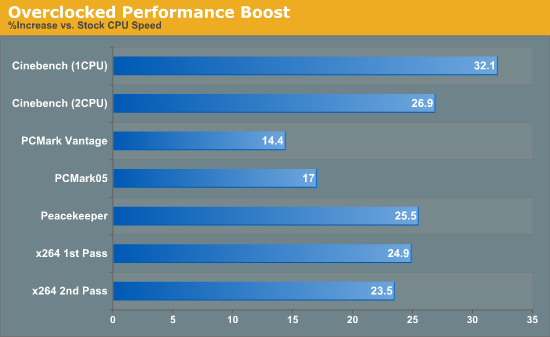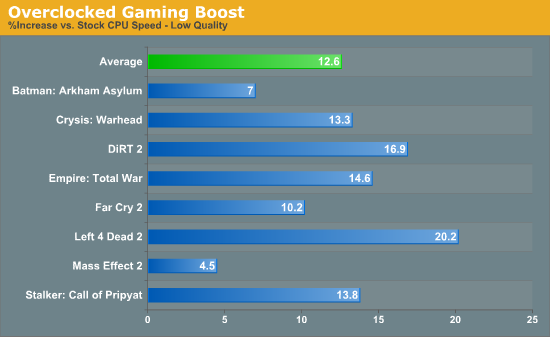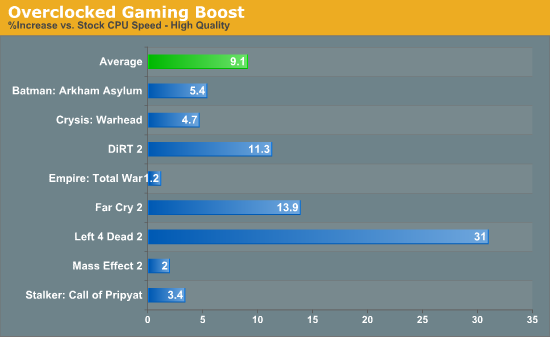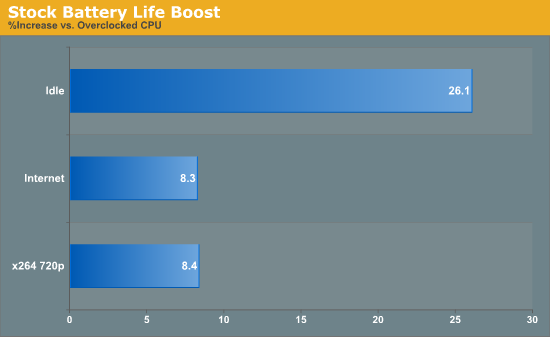Alienware M11x: World’s Smallest Gaming Laptop
by Jarred Walton on March 30, 2010 8:16 AM ESTPerformance Preview: Does Overclocking Matter?
Before we get to the actual benchmark results, we thought we'd begin by trying to answer an interesting question. The Alienware M11x—like the ASUS UL series—uses a CULV processor that runs at 1.3GHz by default. We've already done a CULV roundup and came away quite impressed with the platform. CULV laptops can last almost as long as Atom netbooks, and they manage to provide upwards of twice the performance for less than twice the price. The M11x bumps the CULV price up quite a bit, but it adds a potent GPU and allows you to overclock the CPU to 1.73GHz. It does this by raising the FSB from the default 800MHz to 1066MHz (200 base speed to 266 base), just like the ASUS UL series. Curious about how much a 33% overclock gets you? So were we, so we thought we'd begin with a look at the performance increase compared to the stock speed. We'll start with our standard application tests, which are the most likely to show a near-linear increase.

PCMark shows roughly a 15% increase, which is about right considering the HDD and GPU are part of the equation for those suites. Peacekeeper is far more of a CPU specific test, and it shows a 25% increase in performance from the overclock. Cinebench and x264 encoding are both very stressful CPU tests, and again we see very good scaling with clock speed: a 33% higher CPU clock results in 23 to 32% more performance. It's interesting that the single CPU Cinebench result shows a near linear increase with CPU clock speed while the other CPU intensive tests are closer to a 25% increase. More on this in a moment.
Next up let's look at how much gaming performance improves with overclocking. For these tests, we've run two scenarios: we tested the games at the minimum detail settings as well as "high" detail settings. How much of a bottleneck is the CULV processor? Would a faster CPU allow the GT335M to stretch its legs? Let's find out….


The lack of scaling with most of the games is a bit surprising. We figured the GT335M would need a lot more than a CULV processor to hit its stride, but overall the CPU doesn't appear to be a major bottleneck. At lower detail settings, the 33% overclock averages a 12.5% performance increase, with Left 4 Dead 2 showing the largest improvement. Higher detail settings moves the bottleneck more to the GPU in most titles, so the average increase is less than 10%. There are exceptions to the rule, of course, and this time Left 4 Dead 2 shows nearly linear scaling. It may be that the extra particle effects and geometry are to blame, but there is a definite difference and the game goes from 33FPS to 44FPS. Also note that in some of the benchmarks, we are using built-in performance tools that often score a bit higher than what players actually see in real gameplay.
But why aren't we seeing better scaling? Despite what Alienware states on their web pages, according to CPU-Z (and the benchmarks) the overclocked CPU isn't actually running at 1.73GHz. CPU-Z always reported a CPU speed of 1.60GHz when overclocked (266MHz bus with a 6x multiplier) whereas the multiplier is 6.5x (1.30GHz) at the stock bus speed. Perhaps Alienware is limiting the overclock slightly to keep heat output in check, which would explain why most of the gaming results didn't increase quite as much as we had hoped. If the CPU is indeed running at 1.6GHz instead of 1.73GHz, the overclock is only 23% instead of 33%. Even if the overclock isn't quite as high as advertised, though, it's still definitely good for performance.
But what about drawbacks from overclocking? How much battery life, for example, do users lose by running the CPU at a higher clock speed? We tested battery life (with the IGP enabled and the GT335M disabled) at both stock and overclocked settings. Below is the increase in battery life users can get by running the CPU at stock speed.

In low usage scenarios (idle or doing simple office tasks), the overclocked CPU sucks down quite a bit more power. In that case it might be worthwhile to disable the overclock, as 26% more battery life is very significant. In more demanding tasks like surfing the Internet and watching movies, running the CPU at stock doesn't help as much. The reason idle scenarios benefit so much is because the M11x doesn't allow dynamic frequency switching (SpeedStep) when the CPU is overclocked, so it runs at a constant 1.60GHz—twice as fast as the 800MHz speed the CPU sits at when idle and not overclocked. Still, since enabling/disabling the overclock requires a full reboot along with entering the BIOS to change the setting, we'd guess most users will simply leave the system overclocked and not worry about it. In our worst-case battery life test (x264 playback), the M11x delivers upwards of four hours of playback time, and the Internet test lasts over six hours; you'll really need all-day mobility before battery life becomes a major concern.
Now that we've given an overview of what happens with overclocking, let's get to the actual benchmark results. We'll report the best-case result for all of the tests, which means we ran the M11x overclocked for the application and gaming benchmarks, and for battery life tests we disabled the GT335M and ran the CPU at stock speed.










47 Comments
View All Comments
JarredWalton - Wednesday, March 31, 2010 - link
My wife picked Corbin, and I got the middle name (after my one brother). Thanks! :)aodonald - Thursday, April 1, 2010 - link
I love my M11x. I ordered it the day they started taking pre-orders. Also I swapped out the HD for an Intel X-25 160GB SSD. Also using Everest CPU-ID mine says 1.73 Ghz, not 1.6. Also I think my Multiplier stays at 6.5 and doesn't drop to 6.Jarred I realize that you probably use clean images for all your benchmarking but something I think you should really point out to normal users here is how great the standard image of Windows included.
Compared to Sony, ASUS, Acer, HP this image is optimized, no bloatware other than the Alienware tools, which use only about 1-2% of the CPU. Alienware really treats the user nice by providing such an excellent Windows image.
I agree with the review though, Core i5/7, Optimus, glossy display, annoying fan while idle/browsing all detract from the best case scenario.
The fan is definitely the most annoying. Alienware/Dell if you read any of this please release a driver than enhances fan control. Louder but steady would be preferred over sporadic and crazy. Or give the user control :)
Overall I have fallen in love though, I use it way more to actually play games. I have a nice customer Core i5 750, but having a portable, small light computer is great. I love playing RTSs, Turn Based (Total War) and Batman on it, One game I have issues with it Empire Total War - the font isn't read well. Anyone else know how to fix this?
So many PC laptops out there are boring and terrible form factors. The extra thickness for a completely enclosed PC + battery is well worth it. I never swap batteries anyway. Goodbye disk drives! I've purchased everything on Steam or GOG.com for the last 18 months and can't wait for disc drives to die. Alienware did a great job with the computer look and feel. It is the gamer equivalent to the style and attention paid by Apple for the consumer (Minus the LCD…)
There really is no other laptop this cool and small out there for playing games!
JarredWalton - Friday, April 2, 2010 - link
I actually run with the manufacturer install on all laptop tests; the only catch is that I uninstall any bloatware. That means antivirus, Internet security, etc. plus I disable some of the auto-start items that I don't need (automatic updates and webcam tools, for instance). But you're right about the M11x install being nice and clean. Other than the extra Alienware themes, you don't get a bunch of junk you will never use. You can have Alienware pre-install Steam and a few other items, and if you *want* internet security they have that as an option as well. Unlike many Dell (and other OEM) consumer laptops, there's an option for "none" on the security extras.CZroe - Friday, April 2, 2010 - link
I'd love to get one of these because 12" and under notebooks are the only ones that will fit in my magnetic motorcycle tank bag and I've been wanting a gaming notebook to replace my 8.9" Acer Aspire one. So, I've been eagerly researching it since it was first announced.In my research, I've seen Alienware/Dell refer to it as an 11.6" "edge to edge" LCD panel. If here is truly a large bezel on all sides, just what do they mean by this?
Oh, and I'm sick and tired of seeing needlessly truncated right shift keys. There is plenty of room to shift the arrow keys down, you just have to be willing to make a non-rectangular keyboard module. Acer does it and it's hardly "L-Shaped." It doesn't curb my enthusiasm much considering that it is still nearly full size, but I still wanted to point it out.
The measurements indicate that it'll be a tight fit *IF* it fits, so I'm just waiting for it to show up at Best Buy so I can size it up for certain. I know a 13.3" notebook will not fit, so everytime someone suggests that they should have made it larger, I shake my head. I only home the successor sticks to this formula.
It's refreshing to finally see some decent coverage on the battery situation. Engadget's review just dismissively mentioned the internal battery as if we already knew about it, despite them never reporting on it! You have eased my concerns. My Aspire one's battery completely died (will not even pretend to charge) in barely more than a year, possibly due to a bad power plug, but my cheap replacement 9-cell battery gives me the freedom that only the m11x seems to compare with (9-hours).
JarredWalton - Friday, April 2, 2010 - link
The "edge to edge" marketing speak really just means that there's a sheet of plastic on top of the LCD panel that extends from edge to edge. You can see this in the gallery images of the M11x:http://images.anandtech.com/galleries/623/alienwar...
By my measurements, the M11x is about the same size as a 16:10 AR 13.3" laptop already; that's why I suggest they should have just made a 13.3" laptop. I don't mean it should be larger, bur rather they should ditch the large LCD bezel and go with a narrow bezel, a 16:10 LCD panel, and preferably a 1440x900 native resolution. I know it would be tough to have to ditch the "Alienware" logo that sits right under the LCD, but seriously: do people care so much about branding that they would rather have the logo than a better LCD? Obviously the companies care about it, but I'm not advocating for the manufacturers.
In case you're wondering, the M11x has a diagonal chassis measurement of just under 14". An actual 14" laptop with a 16:9 AR display has a diagonal of around 15.6" which would put a 13.3" chassis right about 14.8" (give or take). A normal 11.6" LCD (without a bunch of wasted bezel space) has a diagonal of around 13" for the LCD with Bezel while the M11x LCD and bezel measure 14". So realistically a 12" panel would fit in the M11x without any difficulty, but they would probably need the chassis to be around .5" larger to fit a 13.3" LCD panel in it.
Anyway, if you have a laptop bag that can fit a 13.3" laptop, I'm positive it will fit the M11x (at least in diagonal measurements... the M11x might be slightly thicker than some 13.3" laptops).
Eidorian - Friday, April 2, 2010 - link
I'm waiting for this product to mature in a revision or two. It's amazing to see it start off at $799 given Alienware's previous models. It falls in line above the Atom notebooks and still manages to hold its own against other CULV notebooks.My main interest right now is how well Battlefield: Bad Company 2 runs on it.
osideplayer - Monday, October 25, 2010 - link
Well it seems like the Nvidia 197.xx. will be the last drivers for the m11x R1. I went ahead aand purchased the laptop anyways. I was able to get it for 550 w/ the su7300 +4gb bgn and etc. I took this review and your newer one into serious consideration before i took the plunge, but relatively i wanted to ask, will its latest drivers and ssd increase frame rate performance. Now that ssd's are plumeting im looking to purchase one for my m11x. What would you say? Also i was curious... what drivers did u use for the graphics card. I noticed, on ur m11x r2 review, the frame rate referenced for the m11x were the same as this review. Thus either drivers made no difference or you did not have time update and retest.Either way i appreciate your review. Anandtech is one of the most reliable sources for thirough and comprehensive reviews. Way better than any video review. You guys really do things right.